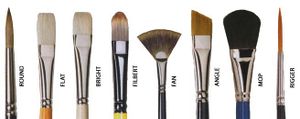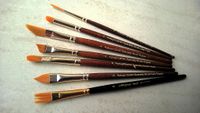Paintbrush
A paintbrush is a brush used to apply paint or sometimes ink. A paintbrush is usually made by clamping the bristles to a handle with a ferrule. They are available in various sizes, shapes, and materials. Thicker ones are used for filling in, and thinner ones are used for details. They may be subdivided into decorators' brushes used for painting and decorating and artists' brushes use for visual art.
Artist's brush shapes
The styles of brush tip seen most commonly are:
- Round: pointed tip, long closely arranged bristles for detail.
- Flat: for spreading paint quickly and evenly over a surface. They will have longer hairs than their Bright counterpart.
- Bright: shorter than flats. Flat brushes with short stiff bristles, good for driving paint into the weave of a canvas in thinner paint applications, as well as thicker painting styles like impasto[Note 1] work.
- Filbert: flat brushes with domed ends. They allow good coverage and the ability to perform some detailed work.
- Fan: for blending broad areas of paint.
- Angle: like the filbert, these are versatile and can be applied in both general painting application as well as some detail work.
- Mop: a larger format brush with a rounded edge for broad soft paint application as well as for getting thinner glazes over existing drying layers of paint without damaging lower layers to protect the paintbrush
- Rigger: round brushes with longish hairs, traditionally used for painting the rigging in pictures of ships. They are useful for fine lines and are versatile for both oils and watercolors.
- Stippler and deer-foot stippler: short, stubby rounds
- Liner: elongated rounds
- Dagger looks like an angle with longish hairs, used for one-stroke painting like painting long leaves.
- Scripts: highly elongated rounds
- Egbert: a filbert with extra long hair, used for oil painting
- Some other styles of brush include
- Sumi: Similar in style to certain watercolor brushes, also with a generally thick wooden or metal handle and a broad soft hair brush that when wetted should form a fine tip. Also spelled Sumi-e (墨絵).
- Hake (刷毛): An Asian style of brush with a large broad wooden handle and an extremely fine soft hair used in counterpoint to traditional Sumi brushes for covering large areas. Often made of goat hair.
- Spotter: Round brushes with just a few short bristles. These brushes are commonly used in spotting photographic prints.
- Stencil: A round brush with a flat top is used on stencils to ensure the bristles don't get underneath. Also used to create texture.
Artists' brush bristles
Bristles may be natural—either soft hair or hog bristle—or synthetic.
- Types include
- watercolor brushes which are usually made of sable, synthetic sable or nylon;
- oil painting brushes which are usually made of sable or bristle;
- acrylic brushes which are almost entirely nylon or synthetic.
Turpentine or thinners used in oil painting can destroy some types of synthetic brushes. However, innovations in synthetic bristle technology have produced solvent-resistant synthetic bristles suitable for use in all media. Natural hair, squirrel, badger or sable are used by watercolorists due to their superior ability to absorb and hold water.
- Soft hair brushes
The best of these are made from kolinsky sable, other red sables, or miniver (Russian squirrel winter coat; tail) hair. Sabeline is ox hair dyed red to look like red sable and sometimes blended with it. Camel hair is a generic term for a cheaper and lower quality alternative, usually ox. It can be other species, or a blend of species, but never includes camel. Pony, goat, mongoose and badger hair are also used.
- Hog bristle
Often called China bristle or Chungking bristle. This is stiffer and stronger than soft hair. It may be bleached or unbleached.
- Synthetic bristles.
These are made of special multi-diameter extruded nylon filament, Taklon, or polyester. These are becoming ever more popular with the development of new water-based paints.
Brush parts
- Bristles: Transfer paint onto the substrate surface
- Ferrule: Retains the bristles and attaches them to the handle
- Handle: The intended interface between the user and the tool
- More information is available at [ Wikipedia:Paintbrush ]
See also Sensation play (BDSM) and/or Pervertable
Notes
- ↑ a technique used in painting, where paint is laid on an area of the surface in very thick layers
External links
Chat rooms • What links here • Copyright info • Contact information • Category:Root


